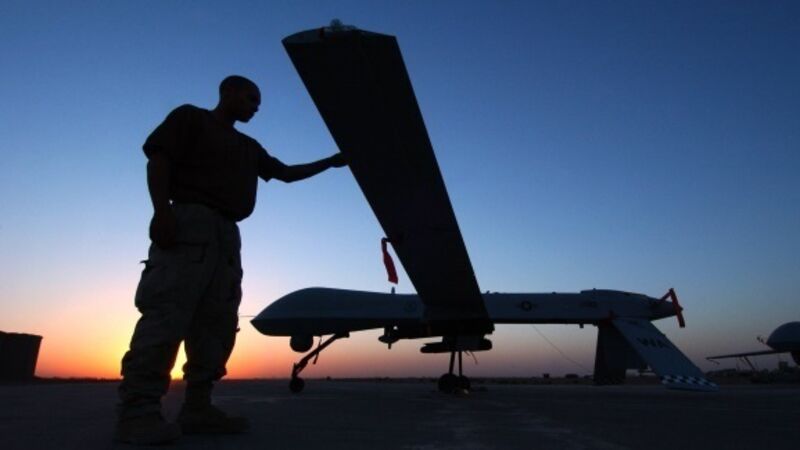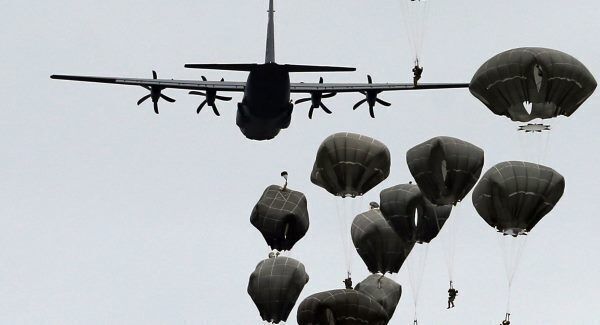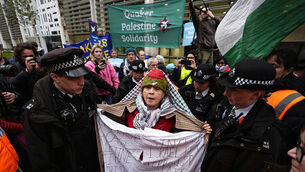One soldier's mental wounds from the harrowing reality of drone wars

Even soldiers who fight wars from a safe distance have found themselves traumatised. Could their injuries be moral ones? reports.
In the spring of 2006, Christopher Aaron started working 12-hour shifts in a windowless room at the Counterterrorism Airborne Analysis Centre in Langley, Virginia.
He sat before a wall of flat-screen monitors that beamed live, classified video feeds from drones hovering in distant war zones.
On some days, little of interest appeared on the screens, either because a blanket of clouds obscured visibility or because what was visible — goats grazing on an Afghan hillside, for instance — was mundane, even serene.
Other times, what unspooled before Aaron’s eyes was jarringly intimate: coffins being carried through the streets after drone strikes; a man squatting in a field to defecate after a meal (the excrement generated a heat signature that glowed on infrared); an imam speaking to a group of 15 young boys in the courtyard of his madrasa.
If a Hellfire missile killed the target, everything the imam might have told his pupils about America’s war with their faith would be confirmed, Aaron thought.
The infrared sensors and high-resolution cameras affixed to drones made it possible to pick up such details from an office in Virginia. But as Aaron learned, identifying who was in the crosshairs of a potential drone strike wasn’t straightforward.
The feed on the monitors could be grainy and pixelated, making it easy to mistake a civilian trudging down a road with a walking stick for an insurgent carrying a weapon. How certain could Aaron be of who they were?
“On good days, when a host of environmental, human, and technological factors came together, we had a strong sense that who we were looking at was the person we were looking for,” Aaron said.
“On bad days, we were literally guessing.”
Initially, the good days outnumbered the bad ones for Aaron. He wasn’t bothered by the long shifts, the high-pressure decisions, or the strangeness of being able to stalk — and potentially kill — targets from thousands of miles away.
Although Aaron and his peers spent more time doing surveillance and reconnaissance than coordinating strikes, sometimes they would relay information to a commander about what they saw on-screen, and “60 seconds later, depending on what we would report, you would either see a missile fired or not,” he said.
Other times, they would trail targets for months. The first few times he saw a Predator drone unleash its lethal payload — the camera zooming in, the laser locking on, a plume of smoke rising above the scorched terrain where the missile struck — he found it surreal, he told me. But he also found it awe-inspiring. Often, he experienced a surge of adrenaline, as analysts in the room exchanged high-fives.
Aaron began working as an imagery analyst at the N.G.A. in 2005, studying satellite pictures of countries that had no link to the war on terror. Not long after he arrived, an email circulated about a US Department of Defense task force that was being created to determine how drones could help defeat Al Qaeda.
Aaron answered the call for volunteers and was soon working at the Counterterrorism Airborne Analysis Center. He found it exhilarating to participate in a war he saw as his generation’s defining challenge. His pride deepened as it became clear that the task force was having a significant impact and that the use of drones was increasing.
Aaron spent a little over a year at the taskforce, including several months in Afghanistan, where he served as the point of contact between the drone centre in Langley and Special Forces on the ground.
After this, he worked for a private military contractor. In 2010, an offer came from another contractor involved in the drone programme to serve as an imagery-and-intelligence analyst.
But as Aaron mulled the terms, something strange happened: He began to fall apart, physically. The distress began with headaches, night chills, joint pain. Soon, more debilitating symptoms emerged — waves of nausea, eruptions of skin welts, chronic digestive problems.
Working for the contractor was out of the question. “I could not sign the paperwork,” he said. Every time he sat down to try, “my hands stopped working — I was feverish, sick, nauseous.”
Aaron went back to Lexington to live with his parents and recuperate. He was 29 and in the throes of a breakdown.
“I was very, very unwell,” he told me. He consulted several doctors, none of whom could specify a diagnosis. In desperation, he experimented with fasting, yoga, Chinese herbal medicine.
Eventually, his health improved, but his mood continued to spiral. Aaron couldn’t muster any motivation. He spent his days in a fog of gloom. At night, he dreamed that he could see — up-close, in real time — innocent people being maimed and killed, their bodies dismembered, their faces contorted in agony.
It has been 16 years since a missile fired from a drone struck a Toyota Land Cruiser in northwest Yemen, killing all six of its passengers and inaugurating a new era in American warfare.
Today, targeted killings by drones have become the centrepiece of US counterterrorism policy. Although the drone programme is swathed in secrecy — the CIA and the military share responsibility for it — American drones have carried out airstrikes in at least eight countries, analysts believe.
Over the past decade, they have also provided reconnaissance for foreign military forces in half-a-dozen other countries.
According to the Bureau of Investigative Journalism, a London-based organisation that has been tracking drone killings since 2010, US drone strikes have killed between 7,584 and 10,918 people, including 751 to 1,555 civilians, in Pakistan, Afghanistan, Yemen, and Somalia. The US government’s figures are far lower.
The escalation of the drone wars has been met with strikingly little congressional or popular opposition. Unlike the policy of capturing and interrogating terrorism suspects that was adopted after September 11, which fuelled vigorous debate about torture and indefinite detention, drone warfare has been largely absent from public discourse.
Among ordinary citizens, drones seem to have had a narcotising effect, deadening the impulse to reflect on the harm they cause. Then again, the public rarely sees or hears about this harm.
The sanitised language that public officials have used to describe drone strikes (‘pinpoint,’ ‘surgical’) has played into the perception that drones have turned warfare into a costless and bloodless exercise.
But the more we have learned about drone fighters, the more this has been revealed as a fantasy.
In one recent survey, Wayne Chappelle and Lillian Prince, researchers for the School of Aerospace Medicine at Wright-Patterson Air Force Base, in Fairborn, Ohio, drew on interviews that they, and other colleagues, conducted with 141 intelligence analysts and officers involved in remote combat operations to assess their emotional reactions to killing.
Three-fourths reported feeling grief, remorse, and sadness. Many experienced these “negative, disruptive emotions” for a month or more.
According to another recent study conducted by the Air Force, drone analysts in the “kill chain” are exposed to more graphic violence — seeing “destroyed homes and villages,” witnessing “dead bodies or human remains” — than most Special Forces on the ground.

As the volume of drone strikes has increased, so, too, have the military’s efforts to attend to the mental well-being of drone warriors.
Last year, I visited Creech Air Force Base, in Nevada, to interview drone pilots about their work. Forty minutes north of Las Vegas, Creech is a constellation of windswept airstrips, surrounded by sagebrush and cactus groves.
It is home to some 900 drone pilots, who fly missions with MQ-9 Reapers in numerous theatres. Creech also has a group of embedded physiologists, chaplains, and psychologists called the Human Performance Team, all of whom possess the security clearances required to enter the spaces where drone pilots do their work, in part so that they can get a glimpse of what the pilots and sensor operators experience.
Drone warriors shuttle back and forth across such boundaries every day. When their shifts end, the airmen and women drive to their subdivisions alone, like clerks in an office park.
One minute, they are at war; the next, they are at church or picking up their children from school. A retired pilot, Jeff Bright, who served at Creech for five years, described the bewildering transition.
“I’d literally just walked out on dropping bombs on the enemy, and 20 minutes later I’d get a text — ‘can you pick up some milk on your way home’?”
Bright enjoyed serving in the drone programme and believed that he was making a difference, a sentiment I heard repeatedly at Creech. But other airmen in his unit struggled to cope with stress, he said — there were divorces and some suicides.
Before the drone personnel at Creech make their way home, some drop by the Airman Ministry Center, a low-slung beige building, equipped with a foosball table, some massage chairs, and several rooms where pilots and sensor operators can talk with clergy.
A chaplain named Zachary told me that what most burdened the airmen he spoke to was not PTSD; it was inner conflicts that weighed on the conscience. He mentioned one pilot, who asked, “I’m just curious: What is Jesus going to say to me about all the killing I’ve done?”
Despite their distance from the battlefield, drone operators’ constant exposure to “gut-wrenching” things they watched on-screen — sometimes resulting directly from their own split-second decisions, or, conversely, from their inability to act — could cause them to lose their spiritual bearings and heighten their risk of sustaining a very different kind of battle scar: what some psychologists, as well as Zachary, have described as a ‘moral injury.’
The term is not new. It appeared in the 1994 book, Achilles in Vietnam, by the psychiatrist, Jonathan Shay, who drew on Homer’s epic war poem, the Iliad, to probe the nature of the wounds afflicting veterans of the Vietnam War.
Shay read the Iliad as “the story of the undoing of Achilles’ character,” which, he argued, unravels when his commander, Agamemnon, betrays his sense of “what’s right,” triggering disillusionment and the desire “to do things that he himself regarded as bad.”
Fifteen years later, the term ‘moral injury’ began to appear more frequently in the literature on the psychic wounds of war, but with a slightly different meaning.
Where Shay emphasised the betrayal by authority figures of what’s right, a new group of researchers expanded the focus to include the anguish that resulted from “perpetrating, failing to prevent, or bearing witness to acts that transgress deeply held moral beliefs,” as a 2009 article in the journal, Clinical Psychology Review, proposed.
They defined it as a wound sustained when soldiers wading through the fog of war betrayed themselves, through harmful acts they perpetrated or watched unfold.
This definition took shape against the backdrop of the wars in Iraq and Afghanistan, chaotic conflicts in which it was difficult to distinguish between civilians and insurgents, and in which the rules of engagement were fluid and grey.
The meaning and magnitude of moral injury remain contested. “It is not widely accepted by the military or the psychological community,” Wayne Chappelle, of the School of Aerospace Medicine at Wright-Patterson Air Force Base, told me, adding that he did not believe it was prevalent among drone operators.
This was somewhat surprising, because Chappelle was an author of the study revealing that many drone warriors struggled with lasting negative emotions after strikes, feeling “conflicted, angry, guilty, regretful.”
But the idea that war may be morally injurious is a charged and threatening one to many people in the military.
Tellingly, Chappelle described moral injury as “intentionally doing something that you felt was against what you thought was right,” like the wanton abuse of prisoners at Abu Ghraib.
The definition used by researchers like Shira Maguen, one author of the Clinical Psychology Review article, is at once more prosaic and, to the military, potentially more subversive: Moral injury is sustained by soldiers in the course of doing exactly what their commanders, and society, ask of them.
Aaron kept his misgivings mainly to himself, but his friends noticed a change in him, among them Chris Mooney, who picked him up at the airport when he returned from Afghanistan in 2009. He and Aaron had been friends since college, when Aaron exuded confidence and enthusiasm. “He was magnetic,” Mooney said.
At the airport, Mooney could scarcely recognise his friend. His affect was flat, his face a solemn mask. They went to dinner, where, at one point, a patron who overheard them talking came up to Aaron to thank him for his service.

Aaron thanked him back, Mooney said, but in a muted tone. Mooney didn’t press him for details, but he knew that something was seriously wrong.
“It wasn’t the same guy,” he said.
In the years that followed, as Christopher Aaron’s mood darkened, he withdrew, sinking into a prolonged period of shame and grief. He avoided seeing friends and had no interest in intimate relationships.
He struggled with “quasi-suicidal” thoughts, he told me, and with facing the depth and gravity of his wounds, a reckoning that began in earnest only in 2013, when he made his way to the Omega Institute, in Rhinebeck, N.Y., to attend a veterans’ retreat run by a former machine-gunner in Vietnam.
The weather was rainy and overcast. The discussion groups he sat in on, where veterans cried openly as they talked about their struggles, were no more uplifting.
But for the first time since leaving the drone programme, Aaron felt that he didn’t have to hide his true feelings.
Every morning, he and the other veterans would begin the day by meditating together. At lunch, they ate side by side in silence, a practice called ‘holding space.’
In the evenings, he drifted into a deep sleep, unperturbed by dreams. It was the most peaceful sleep he’d had in years.
The secrecy of the drone programme makes it riskier for people who have served in it to share their stories. After Aaron began speaking publicly about his own past, someone hacked into his email and his mobile, and a stream of anonymous threats began flooding his inbox.
The hostile messages, calling him “scum” and warning him to “shut his big blabbermouth,” were also sent to his father, whose email was likewise hacked.
The experience left Aaron shaken. But in recent months, he has begun to recover. He is now gainfully employed as an analyst of gold and other precious metals, a hobby he has turned into a vocation.
He has started to reach out again to friends like Chris Mooney. His physical pain has mostly gone away, thanks in part to his regimen of yoga and meditation.
He still has his share of violent dreams. But he appears to have recaptured what for many years he had lost — his sense of moral purpose and, oddly enough, clarity, which is why he feels more ready to continue speaking publicly about his experience.
Not long ago, Aaron was invited to speak at an event organised by a branch of the Mennonite Church, titled ‘Faithful Witness in a Time of Endless War.’ It took place on the campus of a school, in a small auditorium whose stage was festooned with peace quilts.
Aaron approached the lectern. He was wearing a brown blazer, and he had a sombre expression. He reached forward to adjust the mic and thanked the event’s organisers for inviting him to tell his story.
Before sharing it, he asked for a moment of silence, “for all of the individuals that I killed or helped to kill.”















